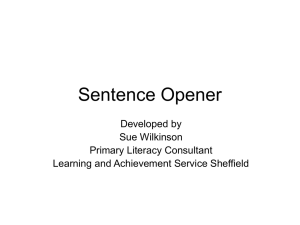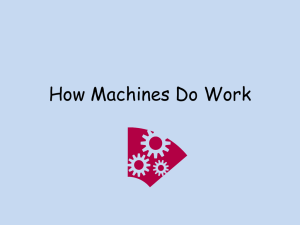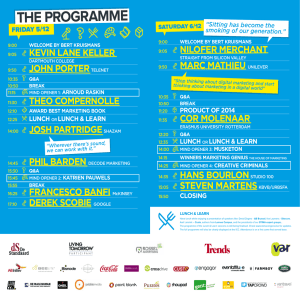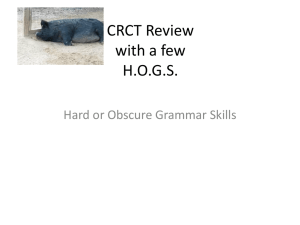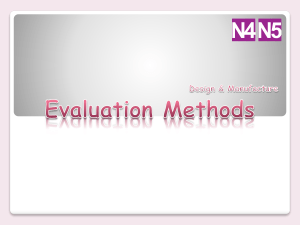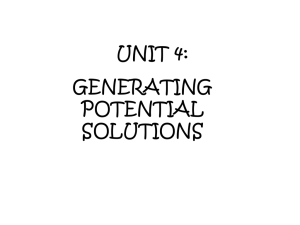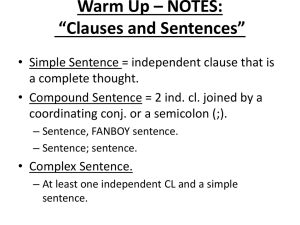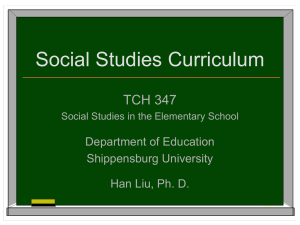Brief Development Level 6 - Technology NZ
advertisement
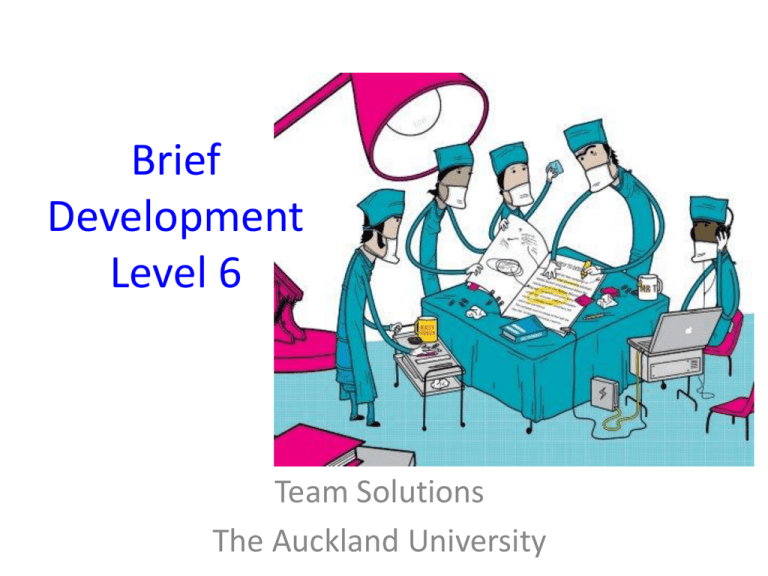
Brief Development Level 6 Team Solutions The Auckland University Learning Intentions • Understanding the curriculum thinking behind brief development • Develop teaching and learning strategies for brief development • Know how to formulate a conceptual statement, identifying a need and or opportunity and how to write a performance specification • Developing an assessment schedule Brief development is…. • One of the components of the three strands of the revised technology curriculum in The New Zealand Curriculum (2007). They provide explanations of the knowledge and/or practices underpinning each of the eight components from which the technology achievement objectives have been derived. Reading: Brief Development • Discuss with others the one key aspect that resonated with you from the reading of the Brief Development explanatory paper. • Abstract • The purpose of this explanatory paper is to clarify and define what a brief is and how it is developed as part of Technological Practice. It presents the component descriptor, the key ideas underpinning it, and illustrative examples of these from technology and technology education. • A brief in technology is defined as a succinct guiding document that is comprised of a conceptual statement that communicates, via any appropriate means (e.g. through oral, written, graphical means), the focus and justified purpose of the Technological Practice to be undertaken to develop a Technological outcome. That is, an explanation for what is to be done and why it should be done. This statement is based on findings from the exploration, and analysis of the context and issue from which the need or opportunity driving the project has been identified. Curriculum level 6 What needs teaching? Pedagogical strategies? • Discuss in groups what you believe needs teaching? 1. Literacy What do these words mean? • • • • • • • Brief specifications Conceptual statement Attributes Specifications Context Issue Stakeholders Activity: Match up questions with answers in pairs 2. Washing Line Strategy • Aim to generate discussion and thinking around a process for brief development Activity: 1. Using all the words arrange them into an order of process you would expect a student to carry out brief development. 2. Next each team member is allowed to move one word in the order and justify the change. Eventually a “process” for brief development should be agreed upon. If any words are part of the same process they can be placed together. 3. Blank cards are for each group to decide on an aspect that is missing. 4. Using the action words place them next to the relevant process. Context t Issue Conceptual statement Explore/r esearch Tell a story Attributes Alternative use of strategy • Hand out one colour of post it notes with the words • Another colour for the actions. • In groups develop a process by sticking the post it notes to the washing line. An example: yellow for the main concepts/words, blue for action 3. Pet project • Read the article • In groups make assumptions how the couple developed their brief for pet coffins • Record thoughts on given sheet 4. Reverse brief strategy Developing a brief in reverse Possible attributes: Must be efficient when using all citrus fruits Light to hold Comfortable to use Safe to use in dishwasher Easily cleaned Hygienic Minimal maintenance Minimal impact on earth’s footprint No fussy parts Traditional style • Write down the physical and functional specifications, these are measurable. • Develop a conceptual statement • What are the attributes? • How about possible contexts and issues? Specifications: Length 160mm Eight groves that taper from the tip to a length of 90c mm. Recycled rimu - sustainable Shaped handle.. Can be used on all citrus fruits Easy to clean Natural finish Manufactured from one piece Clean lines etc Example of a conceptual statement: Try other technological outcomes Writing a conceptual statement and attributes • Work in groups • Use an article/research to allow students to discuss and identify a need or realise an opportunity • Write a conceptual statement that tells a story about what is to be done and why it should be done • What are the desired attributes? Writing a conceptual statement • A brief is a short, clear statement, which describes the problem to be solved. • The brief could include some background information of the problem. • Details of how the need has come about. • Why you think it is a good problem to pursue. • It must state whom you are solving the problems for. • It must allow for a wide variety of solutions. • Consider the 5 W’s, who, where, what, when, why. • It should not describe the outcome. Example of a conceptual statement Occasionally it is necessary to open the top of a soft drink bottle at home before consuming the contents. I have examined a variety of bottle openers which are sold in local shops but have found them to be either too expensive or unattractive in their design. I have yet to find the particular type of bottle opener shape that I want. Continued… I intend to design and develop a pocket size bottle opener which will be comfortable to hold. The bottle opener will be made from mild steel and the handle may be plastic coated in order in order to produce a comfortable grip. The opener may even have a leather strap in order for it to be hung up when not in use. Possible attributes The handle of the bottle opener has to be comfortable to hold. · The bottle opener has to be able to open the top of the bottle. · The bottle opener has to be pocket size. · The opener has to be strong enough not to break when in use. · The opener shape must be interesting. · The opener can not have any dangerous sharp corners or edges. · The opener may be hung up when not in use. · The opener will be made from mild steel. · The opener may be plastic coated or painted to protect it and to make it comfortable to use. · The opener handle may incorporate wood or plastic. · The opener may have to open a variety of sizes of bottle tops. Teacher given context/issue Context Issue Storage Transporting personal items Preserved food Excess fruit Website Promoting the school Assessment at CL 6 AS 991044 (1.1) Undertake brief development to address a need or opportunity 4 credits Also 4 credits literacy Internal assessment Merit Achieved Explanatory note 2 • • • • • • • Undertake brief development to address a need or opportunity involves: identifying a need or opportunity as a result of exploring the given context and issue reflecting consideration of the social and physical environment reflecting key stakeholder’s opinion describing the outcome to be developed identifying the physical and functional attributes needed for the outcome producing a final brief comprised of a conceptual statement and specifications. • • • Undertake detailed brief development to address a need or opportunity involves: explaining how the need or opportunity is derived from the issue reflecting iterative consideration of the social and physical environment and key stakeholder’s opinion describing the purpose of the outcome, within the intended environment explaining the physical and functional attributes needed for the outcome. Excellence • • • • • Undertake comprehensive brief development to address a need or opportunity involves: justifying why such an outcome should be developed justifying why the identified physical and functional attributes are needed for the outcome. Activity: Questions for directions 1. Number each bullet point for achieved from A to F 2. Look at criteria for merit. Match up the numbers so is the first bullet point a 1, 2 or 3? 3. Do the same for Excellence. 4. Write a question for each criteria Achieved Merit Excellence Assessment schedule Evidence judgements for achieved • The student undertakes brief development to address a student-identified need or opportunity for a personal storage solution. • The student explores the given context (storage) and issue (transporting personal items). • For example, the student explores different types of personal storage solutions, what they are storing, the purpose of the means of storage in relation to the end user and where they are used. • The student identifies a need or opportunity connected to the context and issue in consultation with stakeholders. • For example, the need to carry books and PE gear to school. Step ups to Level 2 NCEA Contact details Lesley Pearce l.pearce@auckland.ac.nz www.technologynz.wikispaces.com
